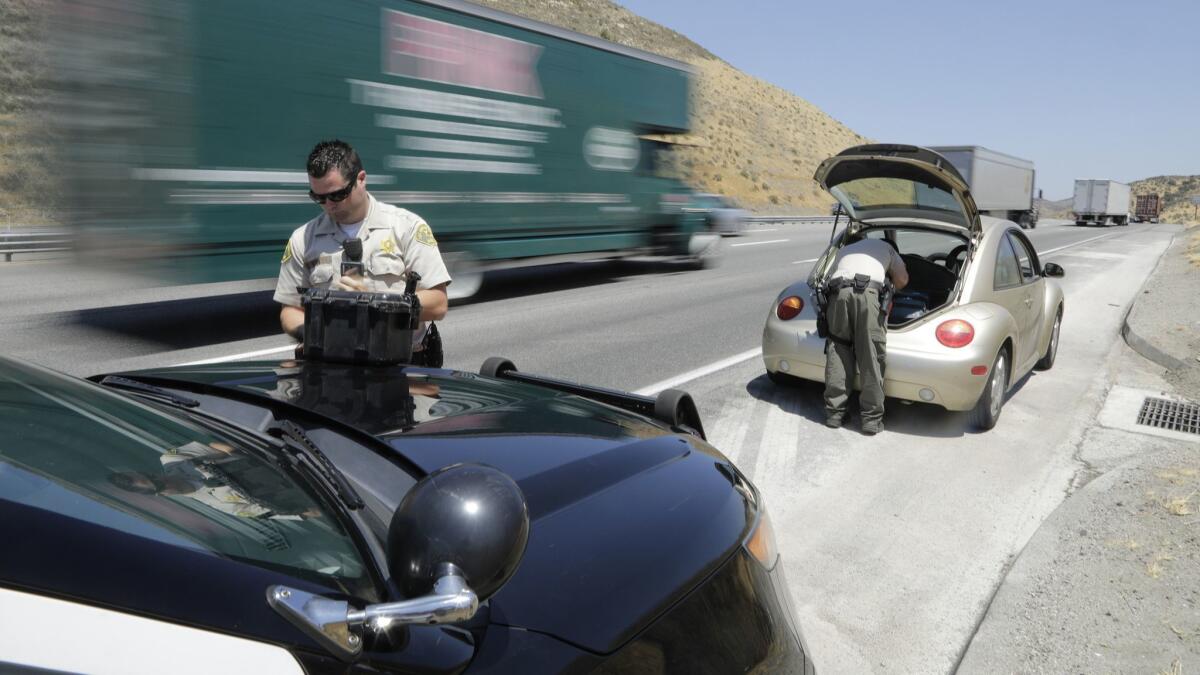Claims of racial profiling on 5 Freeway echo findings against sheriff’s deputies in Antelope Valley

- Share via
For years, black and Latino residents in the Antelope Valley complained they were the victims of racially biased stops and searches along with other mistreatment by Los Angeles County sheriff’s deputies.
The U.S. Department of Justice analyzed Sheriff’s Department data from tens of thousands of vehicle and pedestrian stops, interviewed hundreds of people and reviewed volumes of internal sheriff’s documents before concluding in a landmark case that deputies were engaged in a pattern of biased policing.
The findings forced the county to reach a legal settlement with federal authorities in 2013 that called for significant reforms and a team of monitors whose oversight continues today.
Now the Sheriff’s Department is facing new complaints of racial profiling in the neighboring Santa Clarita Valley over the work of a small team of deputies who have pulled over thousands of innocent Latino drivers on the 5 Freeway in a search for drug traffickers. And, as federal investigators did before, the sheriff’s independent watchdog is looking into the deputies’ actions.
Inspector General Max Huntsman said he is obtaining data from the Sheriff’s Department so his office can examine the deputies’ stops and try to decipher whether they have been targeting Latinos.
Racial profiling analyses have gained renewed attention in recent years amid the rise of the Black Lives Matter movement and broader concerns over racial inequality in the criminal justice system.
In July, California began requiring large law enforcement agencies to collect detailed information on the race, gender and other demographic details every time officers pull drivers over or otherwise detain them. By 2022, all of the state’s police agencies will have to collect the data.
Huntsman’s investigation was launched after The Times analyzed Sheriff’s Department data from more than 9,000 stops by the highway team and found that 69% of the drivers pulled over were Latino and that two-thirds of Latino drivers had their vehicles searched for drugs or other contraband — both far higher rates than for other races. The Times’ analysis also found that drugs or other contraband were discovered in vehicles driven by Latinos at a rate that was not significantly higher than other races.
Sheriff’s officials have denied racial profiling and insist the deputies base their stops only on a person’s driving and other impartial factors. Several racial profiling researchers reviewed the Times findings and said they were a strong indication the deputies were targeting Latinos.
Thomas A. Saenz, president and general counsel of the Mexican American Legal Defense and Educational Fund or MALDEF, echoed the experts’ conclusions, saying the statistics alone are “pretty strong prima facie evidence of racial profiling.”
“The numbers are just too stark,” he said.
But racial profiling experts and civil rights lawyers said numbers alone often are not enough to reveal what motivates law enforcement officers and answer whether bias, if it exists, is intentional. In lawsuits or internal inquiries like the one Huntsman has launched, lawyers and investigators often look for additional evidence to glean what officers were thinking.
“You have to build out a story with circumstantial evidence because nobody is going to say they were targeting Latinos,” Saenz said.
Racial profiling cases have been built using comments officers made either to detained motorists or each other, reports officers wrote, or department policies and the instructions supervisors gave officers.
In one of the nation’s most well-known racial profiling lawsuits, MALDEF and other civil rights groups accused then-Maricopa County Sheriff Joe Arpaio of targeting Latinos in an effort to find immigrants unauthorized to be in the U.S. To make their case, the attorneys used recordings of deputies discussing the need to come up with legitimate reasons to pull over drivers they had already targeted.
“Let’s get our PC,” deputies were recorded saying, referring to probable cause, the legal grounds for stopping drivers, according to Dan Pochoda, former legal director of the ACLU of Arizona, who spearheaded the suit.
The deputies pulled Latino drivers over for speeding or other minor traffic violations but then delved into their immigration status. This tactic of using traffic stops as a pretext for fishing for more serious crimes is widely used by police and does not violate the 4th Amendment’s prohibition on improper search and seizure.
However, if an officer is motivated by the race or ethnicity of drivers when deciding whom to stop, the practice would violate guarantees of equal protection found in the 14th Amendment.
In the Maricopa County case, a federal judge ruled that Arpaio’s office was profiling and improperly detaining Latinos and ordered significant reforms. The class-action case has cost taxpayers more than $70 million in legal fees and other costs, including paying for monitors assigned to ensure the profiling stopped, Pochoda said.
Another federal judge later found Arpaio guilty of criminal contempt for flouting the court’s orders to stop racial profiling. Before Arpaio could be sentenced, President Trump pardoned him last year. By then, the county’s voters had rejected the sheriff’s bid for reelection.
In New York City, civil rights groups challenging the Police Department’s “stop and frisk” policy in a federal lawsuit hired an expert to analyze data on millions of police encounters. He concluded that the policy disproportionately affected black and Latino men.
Darius Charney, an attorney at the New York-based Center for Constitutional Rights who was among those suing the city, said he and others looked for evidence beyond the data to understand what orders police officers had been given.
They collected testimony from more than 100 officers and presented the judge with a recording of a precinct commander ordering an officer to focus his attention on young black men. They also dug up comments a top official made in private to lawmakers in which he acknowledged the program targeted minorities and tried to defend it as a smart strategy, Charney said.
“You’re not going to find a document where they admit to everything,” Charney said. “It’s going to come from talking to a lot of people – going up the chain of command, starting with the officer and then talking to his or her supervisor and then his or her commander…That’s a lot of work.”
The judge concluded that the NYPD’s stop-and-frisk practice amounted to racial profiling. The city eventually abandoned the policy.
The U.S. Department of Justice has conducted dozens of investigations resulting in court-enforced consent decrees or settlement agreements requiring reforms of law enforcement departments. In cases involving allegations of racial profiling, traffic stop data played a key role in the investigations, but additional reviews of department documents and interviews were also significant.
The Trump administration has taken a decidedly different tack, choosing not to pursue such investigations, lawyers said.
The investigation that Justice officials completed in the Antelope Valley offers something of a road map for Huntsman as he looks into the new allegations against the Sheriff’s Department.
Federal investigators started with statistics when trying to make sense of allegations that deputies assigned to the Palmdale and Lancaster stations were discriminating against African American residents, particularly those living in low-income subsidized housing.
They conducted a complex analysis of nearly 49,000 traffic and pedestrian stops that took into account factors such as the area’s crime rates and demographics. Their finding: Blacks, and to a lesser extent, Latinos were considerably more likely than whites to be stopped and searched. The statistical review also found minorities were not more likely to be found with weapons or other contraband.
Justice officials concluded the numbers showed the deputies’ actions had an undeniable “disparate impact” on minorities that “provides circumstantial evidence of discriminatory intent.”
The investigation went beyond the numbers to examine more than 35,000 pages of department documents, interviews with hundreds of people and several days on the ground observing deputies at work. The digging uncovered issues that bolstered the statistical findings, such as a widespread failure by deputies to adequately document their encounters with people and supervisors failing to catch the problem.
As a result of the findings, the county Housing Authority agreed to pay $2 million and the Sheriff’s Department $700,000 to victims of discrimination. The Sheriff’s Department also paid a $25,000 fine and agreed to cover the costs of deputy training, monitoring and data collection.
The team of monitors overseeing the settlement cost the county $870,000 annually on top of hundreds of thousands of dollars more for training Antelope Valley deputies in bias-free policing.
Joseph Brann, a former police chief who serves on the monitoring team, said The Times’ recent analysis of the highway team’s traffic stops on the 5 Freeway were of “great concern” but that he would need more information if he were investigating whether deputies were racially profiling motorists.
Among a lengthy list of question he would have: How are the team’s deputies supervised? Does a separate department unit or outside entity analyze data from the team’s traffic stops? Are deputies targeting a particular type of driver based on behavior or some other factor?
“It’s the organization’s responsibility to ensure this doesn’t occur at either an individual level or as a consequence of poorly thought out organizational policies or practices,” he said.
[email protected] | Twitter: @mauradolan
[email protected] | Twitter: @joelrubin
More to Read
Sign up for Essential California
The most important California stories and recommendations in your inbox every morning.
You may occasionally receive promotional content from the Los Angeles Times.












